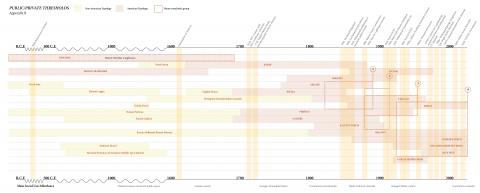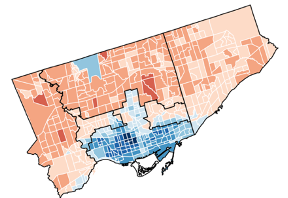line
Population formetics and the circulation of urban forms

This research project looks deeper into the evolution of threshold spaces in the built environment to help us understand the forces that contribute to their adaptation and reproduction in cities. Fueled by the current resurgence in both cultural value and range of activities afforded by them, these spaces reflect shifts in how the built environment enhances or diminishes levels of human interaction. When thinking of public/private thresholds, the word “porch” might come to mind first. Indeed, where privacy is thought of as the domestic, literature on these liminal spaces is dominated by the typology of the porch. Still, people are describing time spent not only on their porches, but on their verandas, galleries, and balconies. Perry (1985) argues that the porch extends the sphere of control from the house into the public arena, while at the same time bounding the public space. More than the mere boundary between public and private, this project’s goal is to uncover the spatial and social differences in the diverse typologies through their evolution. As a work-in-progress, this post outlines some preliminary findings from the project and opens the door to feedback, advice, or any questions sparked by the content.
In Porches of North America (2012) by Thomas Durant Visser, an important resource for this research, the author defines the porch in “the broad contemporary meaning of an identifiable building feature that is open on at least one side or serves as a covered entry and is large enough to shelter at least one person” (p. vii). However, this broad description has also been used for verandas, galleries and piazzas. There isn’t a clear consensus among existing literature on what the exact differences are, as the terms often bleed into each other. These terms have historically been used interchangeably depending on geographic location or social status, rather than describing a morphological difference. For example, “gallery” was most often used in gulf states and French settled regions of Canada (Visser, 2012; Kahn & Meagher, 1990). Further, some scholars claim that the terms gallery, veranda, and piazza were only used to signal a higher social status to the porch, rather than pointing to a spatial difference (Kahn & Meagher, 1990).


As a starting point in detangling the evolution of these terms and typologies, Appendix A classifies these threshold spaces by distilling them into a short description based on their historical use or origin and schematic plan drawing, largely based on Davida Rochlin’s 1976 thesis on the American porch. This series focuses solely on front-facing thresholds, excluding those that faced inner courtyards (such as loggias) or away from the public street, such as back decks and terraces. Rather than organizing by time, the study separates domestic from other non-domestic typologies, as research shows that these liminal spaces had their origins outside of the home. For instance, the Hourd, a medieval scaffolding device used for battle, is considered a potential precursor to the cantilevered balcony. The domestic typologies can also be further separated into spaces created through addition, such as enclosed porches or cloth awnings. Notably absent in this first series is the word “porch” by itself, due to the difficulty in distilling into one defined drawing or definition as previously described above.
Appendix B is a timeline diagram that studies when the previously noted typologies emerged, when they rose in popularity, and potential lineages between them. It is notable how their prevalence was mostly concentrated between the early 19th century to early 20th century. Where there are American and non-American typologies directly following each other, there is a suggested lineage, such as the French galleries and the American gallery. In addition, it is evident in this diagram how little is known of the potential lineage from indigenous and afro-Caribbean typologies. While most pattern books refer solely to European precedents (Downing, 1852) some southern American scholars claim that the front porch was imported through European settlers of Caribbean islands, due to climatic similarities (Perry, 1985; Donlon, 1996).

Along the top of the diagram are important events that marked a change in use or prominence; here we see the effect of the introduction of pattern books resulting in general diffusion of the form, but also that of war and the introduction of new technologies such as the automobile and air conditioning, resulting in an increase in privacy around the 1940’s (Visser, 2012; Wilson-Doenges, 2001). Enclosed and screened porches increased in popularity; layers added on to make them more of a secluded transition space rather than outdoor living spaces. However, even the “transition” quality of them is questionable. Perry (1985) makes a claim that glassed-in enclosures erase the quasi-public nature of the threshold, rather extending the private sphere of the house. By 1990, car garages were a widespread feature of most new houses being built, taking over a large part of the front facade where porches once were. In this way, the garage became the main access to public space, effectively disrupting the threshold at the porch where these worlds overlap. People retreated to the back deck (or more recently, the internet and social media) for social gatherings, preferring a life separated from the noisy and dirty street.
Appendix B also started classifying popular housing styles that were recognized by their porch as a defining feature. In North America, we tend to associate Victorian houses with large threshold spaces, for example. Here we can see a “call out” of four style groups, expanded on in Appendix C, which starts to match popular styles with typologies or words used in association with that style (whether through drawings or written word). The styles were defined by these typologies, but not vice versa. For example, style group 2 encompasses a wide range of terms, despite its short time period. In Appendix C, we see this group is associated with the Queen Anne style. Considering the sense of security and comfort associated with threshold spaces during this period (Visser, 2012), the variety of typologies employed in Queen Anne homes reinforces a linkage between the accumulation of terms and their affordance of opportunities for social engagement.

Though most of existing literature claims an approximately 100 year time period when porches were most popular, we are seeing a comeback in the past few months due to the COVID-19 pandemic lockdown. The term ”porch sitting” was popular in both that time period and today, as it is now considered one of the safest ways to connect with the public. One of the findings from Appendix B is that an increase in popularity corresponds with the increased use of these spaces as community network building, rather than for climate control. On a larger scale, the affordances fluctuate between more social activities and storage/climate control, as seen at the bottom of the diagram. Appendix D looks deeper into this accumulation of affordances throughout time. Further research is needed to describe the discarding of affordances, as the diagram shows a time when these activities were popular but not whether they persisted. It is interesting to note the evolution of these spaces as mediators between sacred spaces to mediators between public/private spaces – has privacy become sacred?

The two last studies, Appendix E and F, look into house plans found in popular pattern books and kit homes, mostly during the time they were most popular up to the 1970’s when the back deck really took over and words like “concrete slab” started replacing the front porch. Click here and here to look closer at the plan analysis. The typologies are highlighted in these plans and color coded for an approximate comparison of size and location. As a general trend in the mid-19th century, verandas were larger and more rectangular in shape, at least 12’ deep and 14’ long. Porches were also included in the plan, but these tended to be smaller areas right where the door was, making them more square in shape and generally not wider than 8’. These findings are consistent with some descriptions found in literature where the authors attempt to clarify subtle differences in typologies (Visser, 2012). In the early 1900’s, porches became larger, taking the place of verandas. This corresponds to the rise of the “leisure class” (Kahn & Meagher, 1990) and the advent of electrical lighting, allowing verandas, or porches, to become deeper. By the end of WWII, these spaces diminished in size, if included in house plans at all. An important finding from this study is the gradual consolidation around the word “porch”, as represented by pink in the diagram. This is best observed in Appendix F, showing a “figure ground” drawing series of the plans analyzed.
The size of thresholds have a linear relationship with the accumulation of affordances. Smaller porch designs from factors described above resulted in less activities taking place on them, thereby reducing their importance in people’s conception of the home, contributing to its continuing decline. This is consistent with Wilson-Doenges’ (2001) research of factors that increase or decrease front porch use in a post 1970’s neighborhood in the United States. This study found that other than pull factors that lead to lifestyles no longer supporting front porch use, small “cartoon” porches where activities are limited is a push factor that reduces porch use.

It is important to note the limitations and biases in the studies performed for this project, notably in the timeline and plan study (Appendix B and E). For instance, the plan study does not consider regional preferences for the terms, as these plans might have been published in parts of the continent where they speak differently. Further, it is mostly concentrated on those published in the United States, marking a bias away from Canada. Frequency of terms or typologies found in these plans are not reflected, as porches were included less often after 1920. However, rather than it being an exhaustive survey of the frequency of a certain typology or exact timeline of its existence, these studies suggest both a general shift in the size and use of them, and a general resurgence of it with respect to the gaining/loss of a certain affordance. Moreover, it suggests a direction of research we could take with machine learning.
Moving forward in this project, in addition to refining and continuing the studies performed, there are a few questions and possible avenues to explore:
- What exactly caused the word “porch” to absorb the wide range of terms and typologies previously used for front facing thresholds?
- Further research into balconies as an important threshold typology. What does it mean when the boundary is not physically accessible to the street, while still visually accessible? This is especially important today as it has seen an increase in affordances attributed to these spaces (food basket delivery in Italy, concerts, exercise).
- Does the linear relationship between affordances and size still hold true today? Is the dimension of threshold spaces more a matter of “social distancing”?
- In the study of the plans, one observation was that the “word” porch was also used over the years to describe the side and back outside features. Why did that stop being used, and why did the “back porch” change to “back deck”? Is it simply a manner of taking off the roof?
- Further research into the evolution of a specific typology through a derailed study of how they were represented in plans over the years.
- Further research into using Google street map view. A preliminary study was done on this, finding it hard to observe a difference over the years shown other than updating the style of the porch. It seems most of the major changes to front facing thresholds occurred before 2007, when GSM was not yet available in Toronto.
- “Push” and “pull” factors (such as Wilson-Doenges 2001 work) from porch use during the Covid-19 pandemic.
- Looking in more detail at a specific lineage as suggested in Appendix B. What are the formal linkages between the typologies, and how did that affect the affordances available through time?
- Translate main findings from this report into UGP’s formal evolutionary model


